Interview mit den Machern von Khet: The Laser Game

Deutsch | English
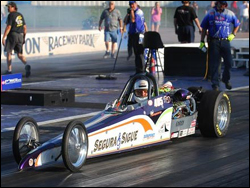 cliquenabend.de: Hello you three, could you give us a brief introduction about yourself, for readers who don´t know you yet?
cliquenabend.de: Hello you three, could you give us a brief introduction about yourself, for readers who don´t know you yet?Del Segura: Del is actually a ´retired´ engineer who worked as a chief engineer at Mitsibushi for several years. In his spare time during his retirement he has built and races his own dragster on the NHRA circuit and is working on getting his PhD to go along with his master´s in
mechanical engineering.
Dr. Michael Larson: Dr. Larson recieved his PhD from MIT and has served as a professor for a number of years at Tulane University and now at the University of Colorado: Colorado Springs. He has conducted research in a wide range of fields from fracture mechanics to high powered energy with a recent focus in laser/tissue interactions. However, he has always taken an active interest in product design and creativity throughout his career. In addition, he has piloted a jet aircraft, steered a nuclear submarine, and can wiggle his ears. One at a time.
Luke Hooper: Luke has an undergraduate degree in biomedical engineering and a master´s in mechanical engineering from Tulane University. He has focused in product design since undergrad initially doing work at Nike Inc. which was a natural fit due to his running obsession which has turned into a triathlon obsession. Luke currently does design work for a number of companies ranging from golf clubs to toys through his design firm Novent Design and also serves as an executive designer at MIND-Studios which is under the direction of Dr. Larson focusing on medical device design.
cliquenabend.de: Who came out with the idea of deflexion (later known as Khet)?
Luke Hooper: Luke came up with the idea during his senior year at Tulane University in an elective product design class taught by Dr. Larson in the Mechanical Engineering Department. The goal of the class was to develop a toy that integrated a new technology and was accessibly to a wide age range. The game idea was sketched out by Luke on a napkin while at lunch trying to think of ways to solve some problems we was having on another laser toy he had initially conceived. Del Segura was also in the class and teamed with Luke on the development of the idea from its origin along with Dr. Larson who encouraged further development of theidea after the class had ended and it was no where near a finished product.
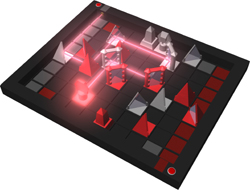 cliquenabend.de: How did you build your first prototypes?
cliquenabend.de: How did you build your first prototypes?Luke Hooper: As I like to say, prototyping is an idea in motion. With that in mind you always start extremely rough to work out the concept and then refine it several times before you arrive at the first show worthy iteration. The game was originally flushed out with pieces of paper and a lot of imagination with geometric drawings simulating various pieces ain order to start to work out the rules. From there, we took an old checkers board and modified it with balsa wood to create a 3D grid that was played upon with pieces milled and lathed out of plastic stock. However, this still didn´t really work. Unfortunately this game requires extremely tight tolerances in order to function properly. Most people realize the laser must be properly aligned, but you also have to have every piece nearly perfect in the horizontal and vertical plane on both the base and mirrored surface. Couple that with the fact that most lasers don´t shoot out of their housing in a straight line and you have a manufacturing nightmare which took nearly a year to solve. So our first working prototype was created with a FDM (fused deposition modelling) rapid prototyping machine done during my first year of grad school during spring break since we had the Tulane Business Plan competition coming up the next week and needed a working model fast!
cliquenabend.de: Why did you change the name?
Luke Hooper: Unfortunately another fellow here in the US created a game in 1990 under the name Deflection which we never found anywhere including online when we were searching for names. He decided to sue us over a trademark dispute. While we didn´t feel we were violating any trademark law due to several reasons, we didn´t have the cash needed to fight it out in court so we took the opportunity to revamp the entire image of the game.
cliquenabend.de: Can you give us a brief description how the game works?
Luke Hooper: The real beauty of the game lies in its simplicity. Players alternate turns moving Egyptian-themed pieces having two, one or no mirrored surfaces. All four types of pieces (pharaoh, obelisk, pyramid and djed column) can either move one square forward, back, left, right, or diagonal, or can stay in the same square and rotate by a quarter twist. Each turn ends by firing one of the lasers built into the board. The laser beam bounces from mirror to mirror; if the beam strikes a non-mirrored surface on any piece, it is immediately removed from play. The ultimate goal is to illuminate your opponent´s pharoah, while shielding yours from harm.

cliquenabend.de: Did you ever thought about other materials like metal or wood?
Luke Hooper: We played around with a lot of materials initially but had to settle on plastic due to manufacturing costs since we wanted to keep the game at an accessible cost. However, we are toying with the idea of producing a limited run of high end Khet games that include all of the features we wanted to originally build in but had to cut out due to cost concerns. This version ideally will be made with a metal plating with the goal of creating a work of art that can stand alone on a coffee table beautifully when not in play.
cliquenabend.de: So a boardgame with lasers that is pretty new stuff. How hard was it to implement it into the game mechanics and board itself?
Luke Hooper: It was a bit of a challenge since it is a very unique mechanic with a lot of possibility. The first question we usually get is why don´t you make the laser moveable, or allow more variation in the angles? We set out with two major goals when developing the gameplay:
1) Create a rule set that can be learned in minutes
2) Make the game appeal to gamers andnon gamers alike.
In other words, we didn´t want to alienate anybody by creating a game so complex they would be afraid to even try for fear of looking stupid which happens with some strategy games. Through early testing, it became appearant that determining the path of the laser even on relatively short paths was a problem for people not engineering or mechanically inclined. So we kept that part as simple as possible while still allowing a very large amount of strategic possibility by making all of the mirrors at 45 degrees so the laser always follows a path with only 90 degree turns. We were literally pulling in every one who passed by our room from janitors and receptionists to professors and engineering students to make sure this game would be enjoyed and be able to be played by anyone. It was a blast and it resulted in a surprisingly simple rule set without sacrificing any complexity in potential strategies. People always think they have the game mastered after playing 20 times and then you show them a counter they hadn´t even though of and they are back to the drawing board. We ran several computer simulations to ensure this.
On a separate note, as mentioned above, manufacturing the game was an engineering challenge in itself that took nearly a year to solve. In the end we had to come up with several manufacturing solutions involving built in laser adjustment, and numerous checks for each piece produced as well as each game before its ever packaged and shipped out.
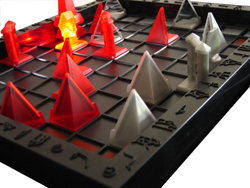 cliquenabend.de: What kind of feedback did you get from boardgame fans?
cliquenabend.de: What kind of feedback did you get from boardgame fans?Luke Hooper: The initial feedback was fantastic. Since none of us were big gamers and this was our first try at developing a game we weren´t sure how the true gamers would receive it. However, we did lots of product testing during the development phases with people who traditionally didn´t play board games. It was received well throughout its development so we had high expectations but the response has been great.
cliquenabend.de: Do you have to turn out the lights in the room for the laser or is there no problem with seeing?
Luke Hooper: The end point of the laser is visible in daylight so there is no need to turn out the lights! Also the pieces are made from translucent plastic so they also diffuse the light and create a glowing effect. However, some people still get confused and wonder why you can´t
actually see the beam path. The power required to do this would not be feasible from a safety standpoint! However, with the addition of smoke, fog, mist, or other airborne particles you can see the beam which creates a neat effect. We often play with a smoke machine, or dry ice which makes you feel like you should be on the set of Star Wars or Star Trek somewhere in the distant past or future.
cliquenabend.de: You also have some expansions for the game ready or in the works. Did it change a lot of the game tactic?
Luke Hooper: Actually all of the expansions being produced as well as future ones planned were all conceived during the initial development of the game but could not be included again due to cost and complexity concerns. So the game was designed with these parts in mind. They definitely add a whole new level of strategy to the game but they add a lot to the game and definitely increase its ´wow´ factor since you´re doing everything
from splitting the beam, to adding another dimension to play.
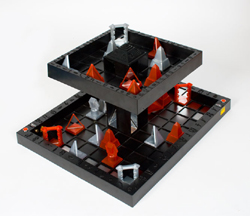 cliquenabend.de: There will also be a new expansion (Khet 3D). Please tell us something about it.
cliquenabend.de: There will also be a new expansion (Khet 3D). Please tell us something about it. Luke Hooper: We´ve been working on the Khet 3D: Tower of Kadesh for a while and unfortunately it won´t be officially released until early 2008 due to production delays. Its an incredible expansion though, literally adding a whole new level to the playing field. The tower adds a 6x6 grid on top of the playing field with four mirrored portals that take the laser
up from the lower level to the upper level. The rules of the game stay the same with pieces being able to move one square in any direction but now they can also move one square up or down when located underneath the tower. In addition, just to add some more mind bending strategy the tower itself can be moved or rotated on a turn in lieu of moving one of your own pieces. (pictures attached). This game is unique in that it draws in anybody who sees it that may be passing by when they glance at lasers being fired around a board. With this expansion it is nearly impossible to walk by this game setup without stopping because it
creates an incredibly intriguing look.
cliquenabend.de: How many copies of the game did you sell till today?
Luke Hooper: To date we have sold around 70,000 units and we hope to eclipse the 100,000 mark by the end of this holiday season.
cliquenabend.de: How can somebody from Europe buy this game?
Luke Hooper: We actually introduced the game into Europe this year and it is for sale in several European countries now.
-In the UK it is being distributed by Hobbygames Inc(www.hobbygames.com) and is placed in several shops already and available online through firebox
-In Sweden and throughout Scandinavia it is being distributed by Engima Games
-In the Netherlands is is being distributed by Productief BV
For more information on direct stores buyers should contact these
distributors.
cliquenabend.de: In Europe the regulations for the use of Lasers in public are a bit stricter then in the USA. What would you have to change for the European version and will this be a problem?
Luke Hooper: The only change that was required was changing the game from a class II laser to a class I laser essentially using a laser that has about half the power of the US version. Most people don´t realize that the typical laser pointer is class III which is 2-5x the power of the class II laser used in the US so these lasers are very low power and very safe in both versions. However, the reduction power does not effect gameplay which we tested extensively before deciding to introduce the game into Europe.
cliquenabend.de: What other games do you like play with friends, besides your own creation?
Luke Hooper: Its been fun getting into the game market because I´ve met some great designers and gotten to enjoy a variety of games I would have never seen otherwise. Personally, I´m a huge fan of Pentago since its another one thats easy to introduce to people and plays quickly. Naturally, I enjoy the GIPF series although sometimes thats a harder sell with a lot of my friends. However, I still enjoy the American classics like Scrabble and Monopoly that I used to play with my family and I´m very big on all types of poker which makes the vegas game conventions extra fun.
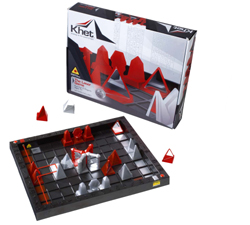 cliquenabend.de: Your YouTube video is very funny, how long did it take to do it and can you tell us more about the production?
cliquenabend.de: Your YouTube video is very funny, how long did it take to do it and can you tell us more about the production?Luke Hooper: Thanks! We had joked around about doing a video using all of the fun lab equipment for a while so we finally decided to put in the time to do it. That was our first experience in video production so we were very surprised and how long it takes to put together 3 minutes of entertaining quality footage. There were three eight hour days of filming with another few hours devoted to clean up alone (if you haven´t seen the video, it involves projectiles including pies, eggs, flour, and water along with lots of fire). The exploding pieces were done with a real high power laser cranked up to around 70 Watts (about 150 x more powerful than the ones used in the game). However, the real time commitment was in the editing which took around 50 hours of total time done with Adobe After Effects. I have a whole new appreciation for directors and video editors which you gain from realizing how much every second has to be though about with transitions, effects, sound, and
content.
cliquenabend.de: Will there be other future projects? What can you say about them?
Luke Hooper: I often get asked about whats coming next when the funny thing is that all three of us have done several other projects since the game, just in different industries. However, I´ve been working on another high tech game on the side for the past two years that we hope to launch next year. I can´t give you any details yet, but we´re going for a whole new high tech mechanic again because innovation is what makes the design work fun and interesting!
cliquenabend.de: Is there anything you would like to tell our readers?
Luke Hooper: We always like to encourage anybody who has a unique idea whether it be in the game industry or another to pursue it. Although it can seem a bit overwhelming to take something from your brain into an actual prototype and on in to production, action is a powerful force and with enough drive and momentum you can figure out the details along the way. The biggest key is just to get started and don´t get frustrated by the inevitable setbacks along the way! We stumbled through a lot of problems creating, producing, and selling this product with no prior experience in the toy industry but in the end its been a great ride and we´ve learned a lot. We´re always happy to lend any advice we can offer to fellow inventors and dreamers.
The interview was held by Kevin Jensen for cliquenabend.de.
Thanks to Luke Hooper for his kind support.
| < vorige Seite | Seite 1 2 | nächste Seite > |


